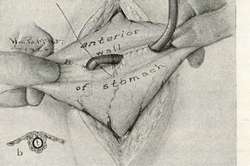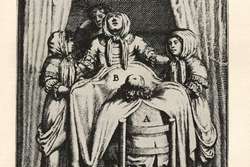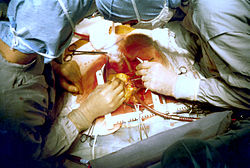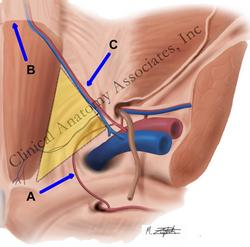
Medical Terminology Daily (MTD) is a blog sponsored by Clinical Anatomy Associates, Inc. as a service to the medical community. We post anatomical, medical or surgical terms, their meaning and usage, as well as biographical notes on anatomists, surgeons, and researchers through the ages. Be warned that some of the images used depict human anatomical specimens.
You are welcome to submit questions and suggestions using our "Contact Us" form. The information on this blog follows the terms on our "Privacy and Security Statement" and cannot be construed as medical guidance or instructions for treatment.
We have 793 guests online

Georg Eduard Von Rindfleisch
(1836 – 1908)
German pathologist and histologist of Bavarian nobility ancestry. Rindfleisch studied medicine in Würzburg, Berlin, and Heidelberg, earning his MD in 1859 with the thesis “De Vasorum Genesi” (on the generation of vessels) under the tutelage of Rudolf Virchow (1821 - 1902). He then continued as a assistant to Virchow in a newly founded institute in Berlin. He then moved to Breslau in 1861 as an assistant to Rudolf Heidenhain (1834–1897), becoming a professor of pathological anatomy. In 1865 he became full professor in Bonn and in 1874 in Würzburg, where a new pathological institute was built according to his design (completed in 1878), where he worked until his retirement in 1906.
He was the first to describe the inflammatory background of multiple sclerosis in 1863, when he noted that demyelinated lesions have in their center small vessels that are surrounded by a leukocyte inflammatory infiltrate.
After extensive investigations, he suspected an infectious origin of tuberculosis - even before Robert Koch's detection of the tuberculosis bacillus in 1892. Rindfleisch 's special achievement is the description of the morphologically conspicuous macrophages in typhoid inflammation. His distinction between myocardial infarction and myocarditis in 1890 is also of lasting importance.
Associated eponyms
"Rindfleisch's folds": Usually a single semilunar fold of the serous surface of the pericardium around the origin of the aorta. Also known as the plica semilunaris aortæ.
"Rindfleisch's cells": Historical (and obsolete) name for eosinophilic leukocytes.
Personal note: G. Rindfleisch’s book “Traité D' Histologie Pathologique” 2nd edition (1873) is now part of my library. This book was translated from German to French by Dr. Frédéric Gross (1844-1927) , Associate Professor of the Medicine Faculty in Nancy, France. The book is dedicated to Dr. Theodore Billroth (1829-1894), an important surgeon whose pioneering work on subtotal gastrectomies paved the way for today’s robotic bariatric surgery. Dr. Miranda.
Sources:
1. "Stedmans Medical Eponyms" Forbis, P.; Bartolucci, SL; 1998 Williams and Wilkins
2. "Rindfleisch, Georg Eduard von (bayerischer Adel?)" Deutsche Biographie
3. "The pathology of multiple sclerosis and its evolution" Lassmann H. (1999) Philos Trans R Soc Lond B Biol Sci. 354 (1390): 1635–40.
4. “Traité D' Histologie Pathologique” G.E.
Rindfleisch 2nd Ed (1873) Ballieres et Fils. Paris, Translated by F Gross
"Clinical Anatomy Associates, Inc., and the contributors of "Medical Terminology Daily" wish to thank all individuals who donate their bodies and tissues for the advancement of education and research”.
Click here for more information
- Details
The root word [-gyne-] is Greek, from [gynaik] meaning "woman" or "female". The suffix [-ology] is also Greek, derived from [logos] meaning "study of". [Gynecology] is then "study of a woman or a female". The term refers to the medical specialty that studies and treats the female reproductive system. A separate specialty, obstetrics, deals with the care of the pregnant patient and delivery of the fetus.
Originally, both specialties were the domain of midwives. It was not until the 1600's that male physicians were allowed to treat gynecological problems and attend births. As the image shows, man-widwifes in Europe were allowed access to the patient only with the use of a "modesty blanket". This is plate XV from the 1681 book "Korte en Bondige Van Der Voortteeling en Kinderbaren" by Samuel Janson.
As an interesting side note in history, the first male physician to work as a man-midwife was Dr. Wertt from Hamburg. Dr Wertt decided to disguise himself as a woman to attend patients. When he was discovered, the punishment was "swift and salutary": He was burned at the stake.
Source:
"The Story of Surgery" by H. Graham, 1939
Word suggested and edited by: Dr. Sanford S. Osher, MTD Contributor
- Details

From the Greek word [stoma] meaning "mouth or opening", and the suffix [-y] meaning "process or condition". The suffix [-(o)stomy] refers to the "process of creating an opening". This process can be physiological, without intervention, as in the creation of a spontaneous fistula, or it can be a surgical procedure.
As a working explanation of [-ostomy] in surgery, we like to use the term "drainage". Therefore, an [ileostomy] would be the procedure by means of which a drainage opening is creating an anastomosis between the ileum and the abdominal wall.
The accompanying image shows an early 1900's procedure to create a gastrostomy (Wietzel's gastrostomy). The root term [gastr-] means "stomach".
- Details
From the Greek [kheirurgia], a compound word meaning "a work done by hand". The Greek word [kheir/cheir] means "hand", and [ergon] means "work". The intent of the word is that of a medical treatment that is realized by the use of the hands and/or hand instrumentation.
Technology has advanced the evolution of surgery. Today minimally invasive surgical procedures, videoscopic procedures, and robotic-enhanced surgery are commonplace.
Images and links in the public domain, courtesy of:www.wikipedia.com
- Details
The arcuate line is the arch-shaped (hence the name) inferior border of the posterior sheath of the rectus abdominis muscle. This structure is seen in a laparoscopic (posterior) view (see image, label "B") and represents the transition from a superior area with well-formed aponeurotic posterior rectus sheath to an area devoid of the posterior rectus sheath.
At this point, the inferior (deep) epigastric vessels (see image, label "C") pass from deep to superficial, under the arcuate line and continue superiorly providing blood to the rectus abdominis muscle.
The arcuate line also represents a transition from a well-formed and stronger wall posterior to the rectus abdominis muscle to a weaker region, covered only by deep muscle fascia and transversalis fascia. This allows a surgeon to enter the preperitoneal region using a Totally Extraperitoneal (TEP) approach for a laparoscopic herniorrhaphy.
Label "A" shows the "corona mortis" anatomical variation.
Image property of: CAA.Inc. Artist: M. Zuptich
- Details
The inguinal (Poupart's) ligament has always been described as a separate, discrete, distinctive ligamentous structure. This is not so. The inguinal ligament is the thickened, incurved, lower free border of the external oblique aponeurosis. This structure extends between the anterior superior iliac spine (ASIS) superolaterally, and the pubic tubercle inferomedially. The inferomedial portion of the inguinal ligament send fibers towars the pectineal ligament (Cooper's ligament) and forms the lacunar (Gimbernat's) ligament.
Inferior to the inguinal ligament is an open region (subinguinal space) that allows passage of structures between the abdominopelvic region and the femoral region. Some of these structures are: Iliacus muscle, psoas major muscle.
Although described by Vesalius, Fallopius, and others it was the French anatomist and surgeon Francois Poupart (1661-1708) who described this structure in relation to hernia in his book "Chirurgie Complete" published in 1695.
Image property of: CAA.Inc. Artist: D.M. Klein
- Details
The suffix [-itis] originates from the Greek and means "inflammation". This suffix is also used to mean "infection", although inflammation is only one of the signs of infection. The symptoms and signs of infection are:
- Edema - localized swelling (tumor)
- Redness- Localized (rubor)
- Localized raise in temperature - Fever (calor)
- Pain - (dolor)
- Localized functional impairment (functio lesa)
The terms in parentheses are the Latin words used to describe these symptoms and sign.
Examples of uses of this suffix are:
- Hepatitis: Inflammation or infection of the liver
- Pancreatitis: Inflammation or infection of the pancreas
- Cholecystitis: Inflammation or infection of the gallbladder [chole-]="gall'; [cyst]="sac" or "bladder"
- Rhinitis: Inflammation or infection of the nose
- Pharyngotracheitis: Inflammation or infection of the pharynx and trachea





